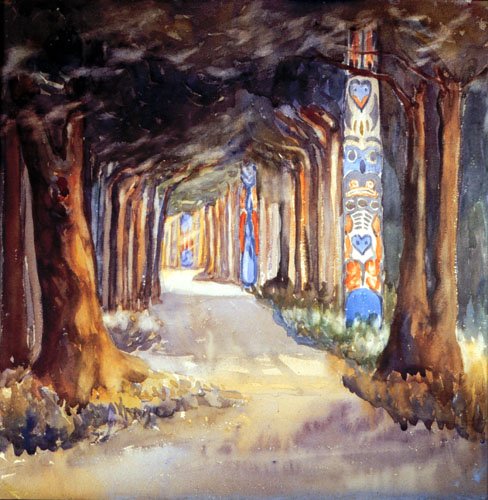Death
Emily Carr is interred in the Ross Bay Cemetery in Victoria. Her gravestone inscription reads "Artist and Author / Lover of Nature". Under Canada's copyright laws, Carr's works became public domain at the beginning of 1996, 50 years after her death. Quotes:
Quotes: "It is not all bad, this getting old, ripening. After the fruit has got its growth it should juice up and mellow. God forbid I should live long enough to ferment and rot and fall to the ground in a squash."
"Twenty can't be expected to tolerate sixty in all things, and sixty gets bored stiff with twenty's eternal love affairs."
"Life's an awfully lonesome affair. You come into the world alone and you go out of the world alone yet it seems to me you are more alone while living than even going and coming."
Early life and education
She was born in Victoria, British Columbia, and moved to San Francisco in 1890 to study art after the death of her parents. In 1899 she travelled to England to deepen her studies, where she spent time at the Westminster School of Art in London and at various studio schools in Cornwall, Bushey, Hertfordshire, San Francisco, and elsewhere. In 1910 , she spent a year studying art at the Académie Colarossi in Paris and elsewhere in France before moving back to British Columbia permanently the following year.[edit] Artistic influences
Emily Carr was most heavily influenced by the landscape and First Nations cultures of British Columbia, and Alaska. Having visited a mission school beside the Nuu-chah-nulth community of Ucluelet in 1898, in 1908 she was inspired by a visit to Skagway and began to paint the totem poles of the coastal Kwakwaka'wakw, Haida, Tsimshian, Tlingit and other communities, in an attempt to record and learn from as many as possible. In 1913 she was obliged by financial considerations to return permanently to Victoria after a few years in Vancouver, both of which towns were, at that time, conservative artistically. Influenced by styles such as post-impressionism and Fauvism, her work was alien to those around her and remained unknown to and unrecognized by the greater art world for many years. For more than a decade she worked as a potter, dog breeder and boarding house landlady, having given up on her artistic career.In the 1920s she came into contact with members of the Group of Seven after being invited by the National Gallery of Canada to participate in an exhibition of Canadian West Coast Art, Native and Modern. She traveled to Ontario for this show in 1927, where she met members of the Group, including Lawren Harris, whose support was invaluable. She was invited to submit her works for inclusion in a Group of Seven exhibition, the beginning of her long and valuable association with the Group. They named her 'The Mother of Modern Arts' around five years later.
The Nuu-chah-nulth of Vancouver Island's west coast had nicknamed Carr Klee Wyck, "the laughing one." She gave this name to a book about her experiences with the natives, published in 1941. The book won the Governor General's Award that year.
[edit] Her written work
Her other titles were The Book of Small (1942),The House of All Sorts (1944), Growing Pains (1946), Pause and The Heart of a Peacock (1953), and in 1966, Hundreds and Thousands. They reveal her to be an accomplished writer. Though mostly autobiographical, they have been found to be unreliable as to facts and figures if not in terms of mood and intent.[edit] Recognition
Emily Carr Institute of Art and Design,cgTW: Emily Carr Grad Show
| 今天去參觀Emily Carr 的Grad Show...超多人也超多作品的...一開始先看Animation 的作品...發現很多有自己的風格,但是一大堆步是太長就是看不懂...animation 也還好. ... |
 Totem Walk at Sitka
Totem Walk at SitkaEmily Carr
Art Gallery of Greater Victoria 94.55.4
Emily CARR (1871-1945)
The Nuu-chah-nulth of Vancouver Island's west coast had nicknamed Carr Klee Wyck, "the laughing one." She gave this name to a book about her experiences with the natives, published in 1941. The book won the Governor General's Award that year.
ISBN:9780888944412 (Paper cover book)
Shadbolt, Doris /Carr, Emily /Publisher:Douglas & McIntyre Ltd Published 2003/05
BookWeb価格: \3,572(税込)
外貨定価:US$ 35.00
円換算額:\3,969 値引額:\397(10% OFF)(税込) (A)
Baker&Taylor
Table of Contents
Preface
Prologue 11 (7)
Artist of the Canadian West Coast
The Woman Behind Carr's Writing
The Painting as Autobiography
The Background 18 (6)
The Victoria Environment
Home and Family
Early Accomplishments 24 (10)
San Francisco
England
Vancouver, Victoria
Commitment to the Indian Theme
French Influence 34 (18)
Painting in France
The French Manner Continued in British
Columbia
Fifteen Years Dormant
Carr at the Turning Point 52 (4)
The Artist at Age Fifty-Six
1927 and the Crucial Trip to Eastern
Canada
The Mature Years Commence 56 (14)
``Religion and Art Are One''
Important Influences: Harris and Tobey
Last Indian Trips
A Formal Period 70 (36)
A Postcubist Reference
Use of Photographs
A New Understanding of the Indian's Art
Shift to the Forests
Wider Contacts/Technical Changes 106(16)
A Broader Context
Developments in Technique
Charcoal Drawings
Oil-on-Paper Sketches
A New Liberation 122(16)
``A Picture Equals a Movement in Space''
The Challenge of Mountains
A New Integration 138(42)
Painting, The Totality of Experience
A Measure of Abstraction
Last Period 180(12)
Return to the Indian Theme
Portraits
Last Nature Paintings
Epilogue 192(6)
A Context of ``Fresh Seeing''
Carr's ``Real Success''
List of Reproductions and Photographs 198(22)
Reference Notes 220(2)
Bibliography 222



沒有留言:
張貼留言